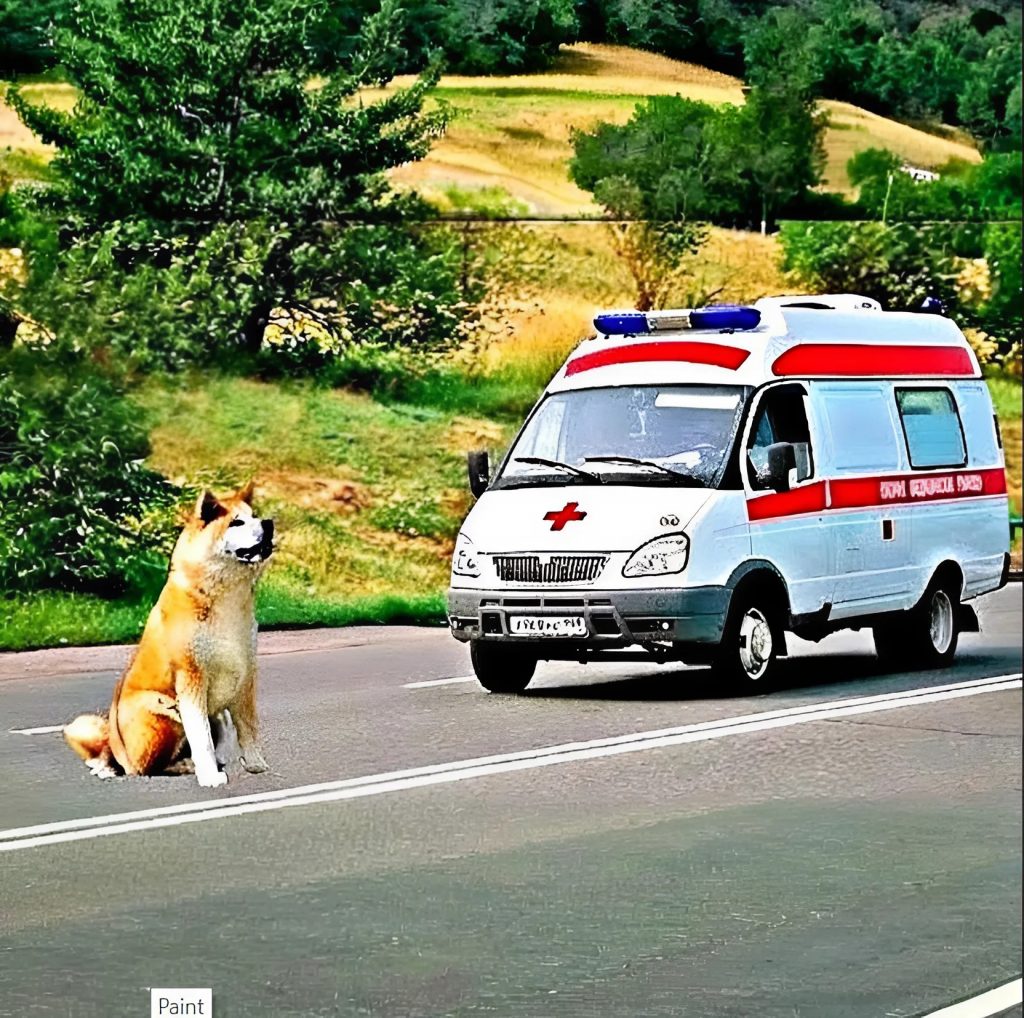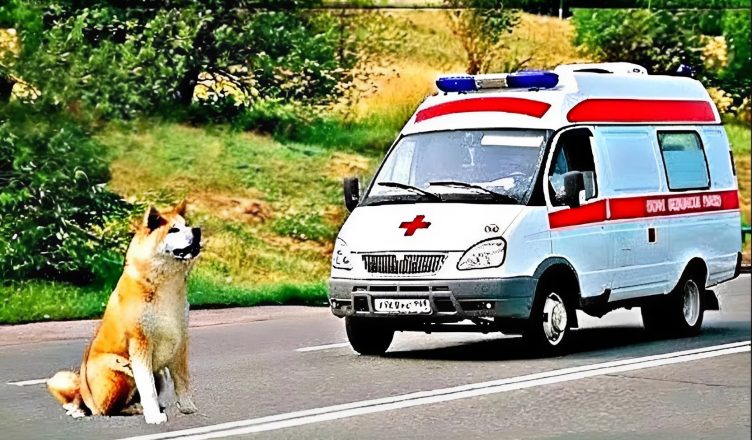The ambulance was returning from a call. It had been a long, exhausting day—one of those days where the radio never goes quiet, where the air is thick with tension, and where the city seems to breathe heavier than usual. The weather didn’t help either. The sky was overcast, the roads slick with rain, and the wind carried a certain chill that made everything feel just a little more urgent.
Inside the ambulance, silence had settled. The paramedics were tired. They had already answered too many calls—some routine, others life-altering. The kind of day that weighed on the body as much as the mind.
Then something unusual happened.
The driver began to slow down. There was no traffic, no red light, no obvious reason. But there, sitting calmly in the middle of the road, was a dog. A beautiful, medium-sized animal—well-fed, clean, with soulful eyes and fur that looked recently groomed. She wasn’t stray in the usual sense. She was still. Too still.
At first, it seemed like she might move on her own. But she didn’t. She didn’t flinch, didn’t bark, didn’t even look startled by the sound of the approaching ambulance. She sat there, composed, looking directly at the vehicle—as if she had been waiting.
The driver honked. Once, then twice. Nothing. The dog didn’t even twitch. It was almost eerie.
Over the years, the medics had seen things that most people would struggle to imagine. They had driven through chaos, picked up the broken and bleeding, delivered babies in parking lots, and held the hands of the dying. But this—this silent, motionless dog—somehow unnerved them.
One of the paramedics, a man who’d served over a decade in emergency response, sighed and got out of the vehicle. He didn’t like delaying, but there was no way around her.
He approached slowly, talking to her the way one does with nervous strays. But the dog wasn’t nervous. She got up—gracefully, almost solemnly—and walked to the edge of the road. Not a run. Not fear. Just a slow, deliberate movement to make way. Her eyes never left him.
Relieved, the paramedic returned to the vehicle.
But as soon as he shut the door, the dog walked right back into the road and sat down again.
Now, everyone inside the ambulance was watching. Something was wrong. This wasn’t random. This wasn’t a confused animal. This was intentional.
The driver stepped out this time, more curious than irritated. He whistled softly. Again, the dog moved aside. She waited at the edge of the road until the paramedic got back inside. Then, with unwavering calm, she returned to her post.
It wasn’t just behavior. It was purpose.
They decided to follow her.
The ambulance crawled forward, and the dog began walking. Not aimlessly. Not skittishly. She walked with intention, occasionally glancing back to make sure they were behind her.

They followed for almost three blocks, turning corners, passing empty lots and half-abandoned buildings. Finally, in front of an old, crumbling house, she stopped.
She turned to look at them, then sat down.
No one spoke. The crew stepped out and approached the house. The front door was open—not wide, just enough to catch the wind and swing slightly on its hinges. There was no sound inside.
The driver knocked. No response.
One of the medics called out. Still nothing.
Protocol be damned—something about the moment demanded action. They entered the house.
Inside, the air was stale. There was clutter, old furniture, a sense of stillness that felt unnatural. Then they heard it—a soft moan, barely audible.
An elderly woman lay on the kitchen floor. She had fallen, possibly the night before, and hadn’t been able to move. Dehydrated, disoriented, and barely conscious, she had no phone within reach. Her voice was too weak to call for help.
They rushed to her aid. Stabilized her. Got her on a stretcher. Her vitals were low, but she was alive.
As they carried her out, the dog stood up and wagged her tail once—just once. No barking. No jumping. Just quiet satisfaction.
They loaded the woman into the ambulance. The dog did not try to follow. She simply sat there and watched, as if her duty was fulfilled.
One of the medics knelt beside her and scratched gently behind her ears.
«Good girl,» he said softly. «You saved her.»
There was no collar. No tag. No indication of ownership. She looked at them a moment longer, then turned and walked away, disappearing down the street.
They never saw her again.
Later, the medics would recount the story to colleagues, to family, to anyone who would listen. Some didn’t believe it. Others wanted to assign logic, to explain it with coincidence or instinct.
But those who were there knew better.
It wasn’t a coincidence. It wasn’t instinct.
It was a message.
Sometimes help doesn’t come from a siren or a uniform. Sometimes it comes on four legs, with quiet eyes and unwavering purpose. Sometimes the most urgent call for help isn’t heard through a dispatch radio—but through the stillness of a dog sitting in the middle of th
